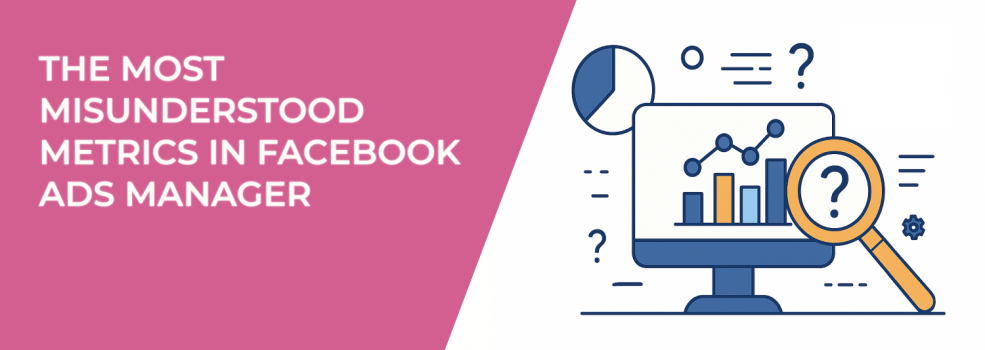If you're running Facebook ads, you've definitely seen the numbers: CTR, CPM, CPC, ROAS, Impressions, Frequency... and the list goes on.
But do you actually know what they mean? More importantly — are you interpreting them correctly?
Many marketers use Facebook Ads Manager like a performance dashboard. But here’s the problem: the most visible metrics aren’t always the most useful. Some can even lead you in the wrong direction.
Let’s break down the most misunderstood metrics in Facebook Ads Manager, explain why they’re tricky, and go over what you should be looking at instead. If you're trying to figure out why your ad campaigns aren't doing what you expected, this is the place to start.
1. CTR (Click-Through Rate)
CTR tells you how many people clicked on your ad compared to how many saw it. It often gets treated like the main sign that an ad is working.
But a high CTR doesn’t mean you're getting the right kind of clicks. People might be curious about your ad, but that doesn't mean they want what you're offering. You could have 500 clicks and still no sales if the people clicking aren't the right match.
Here are a few metrics you should check alongside CTR:
-
Conversion Rate (CVR) — This shows the percentage of people who actually did what you wanted them to do after clicking (like buying a product or signing up).
-
Cost Per Conversion — Tells you how much you're spending to get one actual customer or lead.
-
Landing Page Engagement — Look at how long people stay, how far they scroll, and whether they bounce quickly. That shows if your page fits the promise of your ad.
If you're struggling with low CTR, or you're getting clicks but no results, this guide might help: How to Solve Low Click-Through Rates (CTR) on Facebook Ads.
2. CPM (Cost Per 1,000 Impressions)
CPM tells you how much it costs to show your ad 1,000 times. It's a common number advertisers use to judge whether they're getting good reach for their budget.
But reach alone doesn’t tell you much. If your ad is being shown to the wrong people, it doesn't matter how cheap it is.
Instead of focusing only on CPM, look at:
-
Cost Per Result — This is the actual cost of getting a result, like a lead or sale. It reflects how well your ad is doing in real business terms.
-
Audience Quality — Are you reaching people likely to buy, or just filling the screen with impressions?
If you're seeing low CPMs but also low conversions, the issue probably isn’t your budget — it’s who you're reaching.
3. Frequency
Frequency shows how often the same person sees your ad. Seeing something multiple times can help people remember your brand, but it can also cause frustration if it’s overdone.
A low frequency might mean not enough exposure. A high frequency could mean your audience is too small, or that your ad is running too long without a refresh.
To manage this better, try:
-
Setting frequency caps — These limit how often your ads show to the same person. For example, no more than 3 times per week for cold audiences.
-
Watching for signs of fatigue — If your CPC starts rising, CTR drops, or you get negative feedback, your audience might be tired of seeing the same ad.
-
Tracking performance by frequency — Compare how your cost per result changes as frequency increases. If it goes up too much, it might be time to switch creatives.
More on this here: How Frequency Capping Helps Beat Facebook Ad Fatigue.
4. Relevance Score / Quality Ranking
Relevance score (now part of Facebook's quality ranking metrics) reflects how users respond to your ad — things like clicks, reactions, and negative feedback. It gives you a general sense of how well your ad fits the audience.
However, this number can be misleading. A highly "relevant" ad may get lots of clicks and engagement, but if those interactions don't lead to conversions, you’re still wasting money.
Instead of chasing high relevance scores, pay attention to:
-
CTR and CVR together — High CTR but low conversion rate usually means something is off with your messaging or audience.
-
Engagement quality — Are people saving your ad? Commenting with interest? Or just tagging friends for fun? Not all engagement is useful.
To avoid poor scores and rejected ads, review this checklist: How To Avoid Ad Rejection on Facebook.
5. ROAS (Return on Ad Spend)
ROAS is one of the most important numbers in Ads Manager. It tells you how much money you earned for every dollar spent.
Still, it can be tricky. ROAS doesn’t consider your profit margins, product costs, or customer return rates. A ROAS of 2 might sound good, but if you're only making $5 in profit per sale, you're not really ahead.
For a more complete view, add these to your analysis:
-
Profit margin — Are you actually making money after product, shipping, and fulfillment costs?
-
Customer lifetime value (LTV) — Are customers coming back? Subscription businesses especially need to factor in recurring value.
-
Refund or churn rate — If many of your purchases are refunded, your reported ROAS might be inflated.
Learn how to calculate true returns here: Why You Should Pair ROAS With Customer Lifetime Value (LTV).
6. Impressions vs Reach
These two are often confused:
-
Reach is the number of individual people who saw your ad.
-
Impressions is how many total times your ad was shown (including repeat views).
A big difference between the two means people are seeing your ad more than once. That can be good in moderation, but it might also mean you're burning out your audience.
Here’s what to check:
-
Are you reaching new people consistently? If your reach stops growing, your targeting might be too narrow.
-
Is your frequency going up without better results? You might need to refresh your creatives or expand your audience.
Check out this deeper explanation: Impressions vs Reach: What’s the Difference?
Final Checklist: What to Track (And Why It Matters)
You don’t have to ignore CTR or CPM, but they shouldn't be the only numbers guiding your decisions. Here’s a clearer breakdown of what to monitor closely and what to treat with more caution.
Focus on these for better decision-making:
-
Conversion Rate (CVR): This shows how effectively your ad turns interest into action.
-
Cost Per Result: Whether it’s a lead, sale, or sign-up, this metric tells you the real cost of your outcomes.
-
Customer Acquisition Cost (CAC): Helps determine if you’re spending too much to get each customer.
-
Customer Lifetime Value (LTV): Shows how much a customer is worth over time, especially useful for long-term campaigns.
-
ROAS (with context): Good starting point, but always interpret it with your business margins in mind.
View these as supporting signals, not final answers:
-
Click-Through Rate (CTR): Early indicator of ad appeal, but not of sales.
-
Cost Per 1,000 Impressions (CPM): Reflects delivery cost, not effectiveness.
-
Frequency: Useful for spotting fatigue, but not always bad.
-
Relevance Score / Quality Ranking: Helps with delivery, but doesn’t guarantee conversions.
-
Impressions: Volume without intent isn’t progress.
Understanding your numbers means going beyond surface-level data. Use these metrics together to get a more accurate view of what’s working and what needs attention. The more clearly you read the data, the better your decisions will be — and that leads to campaigns that actually perform.

